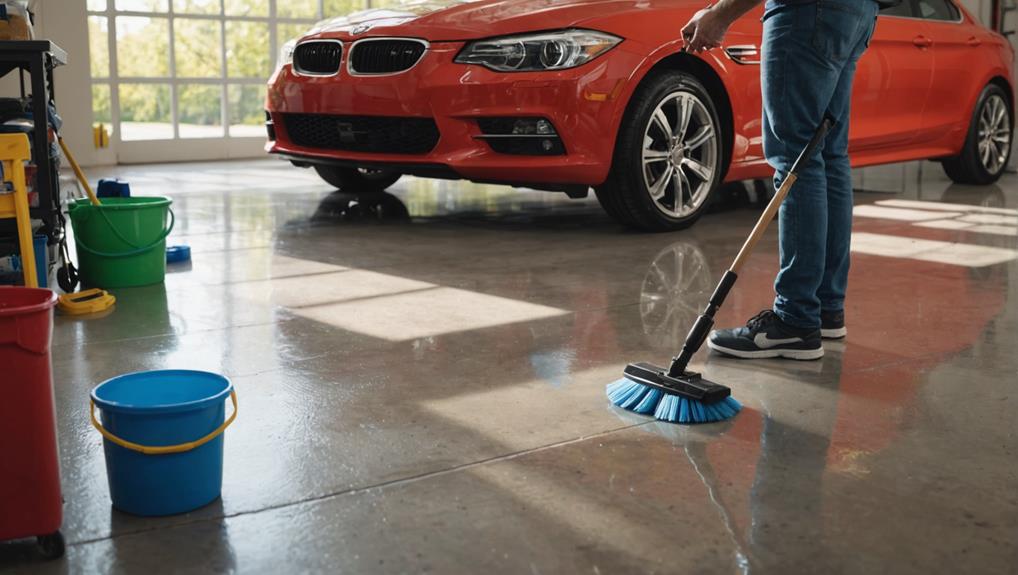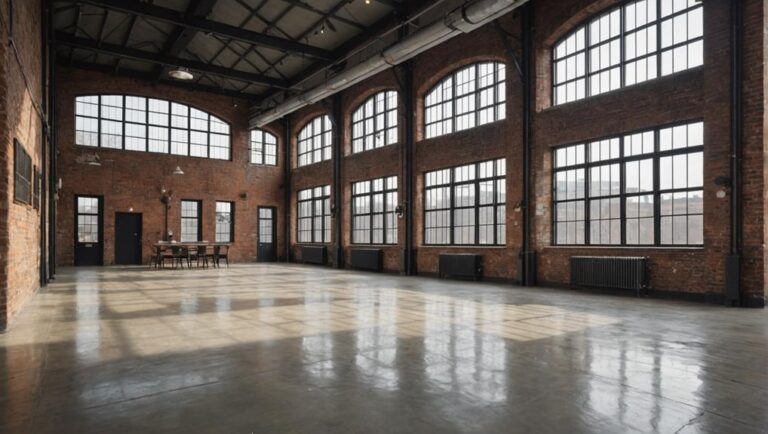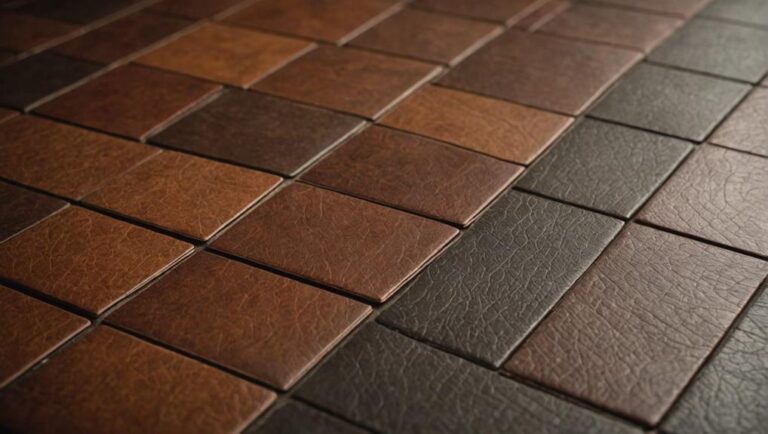To clean and maintain your garage floor, start by identifying its type—concrete, epoxy, tile, or rubber. Gather essential supplies like a stiff-bristle broom, microfiber mop, and a suitable cleaner. Clear the workspace before sweeping or vacuuming the floor. For concrete, scrub with a concrete cleaner and rinse thoroughly. Use a pH-neutral cleaner for epoxy surfaces to protect their finish. Regularly inspect for stains and deal with them promptly to prevent damage. Implement a cleaning schedule to keep it tidy and safe. There's much more to explore about maintenance techniques you'll want to know!
Assessing Your Garage Floor Type
When evaluating your garage floor type, it's important to identify the material, as this will determine the best cleaning methods and products to use. Garage floors typically consist of various surface materials, including concrete, epoxy, tile, and rubber. Each of these floor types requires specific care and attention to maintain safety and appearance.
Concrete is the most common garage floor material. It's durable but can be porous, making it susceptible to stains and spills. For concrete, you'll want to use a degreaser or a mild detergent mixed with water to lift tough stains. Make sure to scrub with a stiff broom or brush for effective cleaning.
If your garage features epoxy flooring, it's necessary to use pH-neutral cleaners. This surface is less porous and generally easier to clean, but harsh chemicals can damage the finish. Regular sweeping and occasional mopping will keep it looking great.
Tile floors, while less common, can vary in materials like ceramic or vinyl. These surfaces usually require a gentle cleaner, especially if grout lines are present. Avoid abrasive tools that could scratch the tiles.
Rubber flooring is another option, offering excellent slip resistance. For this surface type, it's best to use warm water and a mild soap. Using harsh chemicals can degrade the rubber, so always check labels for safety.
Identifying your garage floor type and its surface materials is important for effective cleaning and ensuring a safe environment.
Essential Cleaning Supplies
Having the right cleaning supplies can make a significant difference in how effectively you tackle your garage floor cleaning. To start, you'll need a few essential cleaning tools. A stiff-bristle broom is vital for sweeping away dirt and debris. For tougher stains, a pressure washer can be highly effective, but remember to use it safely to avoid any damage.
When it comes to cleaning solutions, opt for eco-friendly products whenever possible. These options are not only safer for you and your family, but they also minimize environmental impact. Look for biodegradable degreasers to tackle oil stains, and consider vinegar or baking soda for a natural cleaning alternative.
You'll also want to have a mop or scrubbing brush on hand. A microfiber mop is great for picking up fine dust while being gentle on your floor's surface. For those stubborn spots, a scrub brush with stiff bristles will help lift grime without scratching the floor.
Don't forget protective gear, either. Gloves are important to protect your skin from harsh chemicals, and knee pads can make the job more comfortable if you're down on the floor.
Lastly, a bucket for mixing your cleaning solutions is a must. With these supplies at your disposal, you'll be well-equipped to keep your garage floor clean and safe, allowing you to maintain a tidy space without compromising on health or safety.
Preparing for Cleaning
Before you immerse yourself in cleaning your garage floor, it is vital to prepare the space for an efficient and effective process. Start with some thorough cleaning prep to guarantee you're set up for success. Begin by removing all items from the garage, including tools, boxes, and vehicles. This not only clears your workspace but also helps prevent any accidents while you're cleaning.
Once everything is cleared, perform a floor inspection. Look for any cracks, stains, or grease spots that might need special attention. Identifying these problem areas upfront allows you to tackle them more effectively later on. If you notice any significant damage, consider addressing these repairs before you begin the cleaning process.
Next, check your lighting. Good visibility is essential to guarantee you don't miss any spots and can work safely. If necessary, add temporary lighting to brighten up darker areas.
Cleaning Concrete Floors
When it comes to cleaning concrete floors, having the right supplies is key. You'll want to follow a step-by-step process to guarantee a thorough clean, and knowing some effective stain removal techniques can make a big difference. Let's break down what you need and how to tackle the job efficiently.
Essential Cleaning Supplies
Cleaning concrete floors in your garage requires a few essential supplies to make the task efficient and effective. First, you'll need proper cleaning tools, such as a stiff-bristled broom or a vacuum designed for concrete surfaces. These will help you remove dirt and debris effectively before you begin deep cleaning.
Next, consider using a pressure washer, especially for tougher stains. It's a powerful tool that can save you time and effort. Make sure you wear safety goggles and gloves when using it to protect yourself from any debris.
For deep cleaning, you'll want a suitable concrete cleaner. Look for products specifically formulated for concrete, as they effectively break down grease and grime without damaging the surface.
Step-by-Step Process
Getting started on cleaning your garage floor can feel overwhelming, but breaking it down into manageable steps makes it much easier. First, clear out any items in your garage to achieve proper garage organization. Move everything out to guarantee you have a clean workspace and can assess the floor's condition.
Next, sweep up dust and debris using a broom or a vacuum designed for hard surfaces. This step is essential for preventing scratches and making sure that you don't miss any dirt when washing. Once the loose debris is gone, you can prepare your cleaning solution—mix warm water with a mild detergent or a specialized cleaner for concrete floors.
After that, scrub the floor with a stiff-bristled brush or a mop, focusing on high-traffic areas and stains. Rinse the floor thoroughly with clean water to remove any soap residue, which can affect future floor coatings. If necessary, allow the floor to dry completely before moving items back in.
Stain Removal Techniques
Stubborn stains on concrete floors can be a source of frustration, but tackling them effectively can restore your garage's appearance. Understanding the types of stains and using the right removal products is key to achieving a clean surface without damaging the concrete.
Here's a quick reference table for common stain types and recommended removal products:
| Stain Type | Recommended Removal Products | Method |
|---|---|---|
| Oil | Degreaser or dish soap | Scrub with a stiff brush |
| Rust | Vinegar or rust remover | Apply, let sit, scrub |
| Paint | Paint thinner or acetone | Dab, scrape, rinse |
| Grease | Baking soda paste | Apply, scrub, rinse |
| Tire marks | Concrete cleaner | Spray, scrub, rinse |
Before using any removal products, always test them in a small, inconspicuous area to verify they don't damage the concrete. Remember to wear gloves and guarantee proper ventilation. With the right techniques and safety precautions, you can effectively eliminate stains and keep your garage floor looking its best.
Cleaning Epoxy-Coated Floors
Epoxy-coated floors require specific care to maintain their glossy finish and durability. The advantages of epoxy floors, like resistance to stains and easy cleaning, can be overshadowed by common epoxy issues if not managed properly. To keep your floor looking its best, follow these essential cleaning tips.
First, regularly sweep or vacuum to remove dirt and debris. This prevents scratches and keeps your floor safe. Next, mop the surface using a pH-neutral cleaner specifically designed for epoxy. Avoid harsh chemicals, as they can dull the finish or damage the coating over time. Finally, verify you dry the floor thoroughly after cleaning to prevent slips or falls.
Here are three key points to remember:
- Use gentle cleaning tools: Soft mops and microfiber cloths are best for avoiding scratches.
- Avoid abrasive cleaners: Products with strong solvents can lead to common epoxy issues like discoloration or peeling.
- Schedule regular maintenance: Periodic deep cleaning helps prolong the life of your epoxy floor.
Dealing With Oil Stains
When it comes to oil stains on your garage floor, quick action is key. The longer you wait, the more difficult it'll be to remove those unsightly marks. Start by blotting up as much oil as possible with paper towels or rags. Make certain to wear gloves to protect your skin during this process.
Next, you'll want to use oil absorbents, such as cat litter or commercial absorbent products. Spread the absorbent material over the stain, and allow it to sit for a few hours or overnight. This helps draw out the excess oil, making it easier to clean the surface.
After the absorbent has done its job, sweep it up and dispose of it properly. Now it's time to tackle the stain itself. There are various degreaser options available, both commercial and homemade. If you prefer a DIY approach, mixing baking soda with water creates a paste that can effectively lift the stain. Apply the paste to the spot and scrub gently with a stiff-bristled brush.
For tougher stains, you might consider a stronger commercial degreaser. Follow the product's instructions carefully, and always guarantee proper ventilation while using it. Once you've scrubbed the area clean, rinse thoroughly with water. Remember to dry the area completely to prevent slips and falls. With these steps, your garage floor will look better, and you'll maintain a safer environment.
Preventative Maintenance Tips
To keep your garage floor looking great, it's crucial to establish a regular sweeping schedule to remove debris and dust. Don't wait to tackle stains; prompt removal can prevent lasting damage. Additionally, applying a sealant periodically will help protect the surface from spills and wear.
Regular Sweeping Schedule
Keeping your garage floor clean starts with a regular sweeping schedule that can prevent dirt and debris from piling up. By consistently removing dust accumulation and other materials, you not only maintain a cleaner space but also reduce safety hazards. A clean garage floor can help prevent slips and falls, making it a safer environment for you and your family.
To establish an effective sweeping routine, consider the following tips:
- Choose a specific day: Pick a day each week to sweep the garage, ensuring it becomes a regular habit.
- Use the right tools: Opt for a broom with stiff bristles to effectively gather debris and a dustpan for easy debris removal.
- Involve the family: Make it a family activity to encourage everyone to contribute to maintaining the garage's cleanliness.
Prompt Stain Removal
Stains on garage floors can quickly become a permanent eyesore if not addressed immediately. To keep your garage looking its best, it is crucial to practice prompt stain removal. Start by ensuring you can identify various stains—oil, grease, rust, or paint—so you can treat them effectively. Knowing what you're dealing with makes a significant difference in stain prevention and removal.
For oil and grease stains, absorb excess liquid with rags or cat litter, then scrub with a degreaser. Rust stains can often be treated with a mixture of baking soda and water. Paint spills should be tackled while they're still wet; use a paint thinner or solvent before it sets in.
Always wear gloves and a mask to protect yourself from chemicals. After cleaning, consider applying a sealant to your garage floor, as this can enhance stain prevention and make future cleanups easier. By being proactive and addressing stains as soon as they appear, you'll maintain a cleaner, safer garage space. Remember, a little effort now can save you time and hassle later!
Sealant Application Frequency
Once you've tackled those pesky stains, applying a sealant can greatly enhance your garage floor's longevity and appearance. Regularly applying a sealant protects against moisture, chemicals, and wear, ensuring your floor remains safe and durable.
For ideal results, consider these tips on sealant application frequency:
- Sealant Types: Depending on your floor material, choose between epoxy, polyurethane, or acrylic sealants. Each type has unique properties and durability levels, so select one that fits your needs.
- Application Techniques: Follow manufacturer instructions for the best results, ensuring your floor is clean and dry before applying the sealant. Use a roller or sprayer for even coverage.
- Frequency: Generally, you should reapply sealant every 1-3 years. However, if you notice wear or fading, it might be time to reseal sooner.
Seasonal Cleaning Routine
Establishing a seasonal cleaning routine for your garage floor can make the task feel less intimidating and more manageable. By aligning your cleaning schedule with seasonal weather changes, you can guarantee that your garage remains a safe and organized space throughout the year. Start by choosing a specific time each season—perhaps at the start of spring, summer, fall, and winter—to focus on your garage floor.
During your spring cleaning, check for any salt or debris left from winter. Use a broom or vacuum to remove dirt, and then mop the floor with a suitable cleaner to eliminate stains and grime. In summer, you might want to tackle any oil spills from your vehicle. Applying a degreaser can help lift those stubborn stains, guaranteeing your floor stays safe and slip-resistant.
As the weather changes in fall, it's a good idea to declutter your garage. This is the perfect time to assess your garage organization. Consider donating items you no longer need and rearranging tools and equipment for better accessibility. Finally, in winter, inspect for any damage caused by harsh weather. Clean the floor thoroughly to prevent ice buildup and slips.
Long-Term Floor Care Strategies
Maintaining your garage floor doesn't stop with seasonal cleaning; implementing long-term care strategies can greatly extend its lifespan and appearance. To guarantee your garage floor stays safe and visually appealing, consider these floor longevity tips and surface protection methods.
First, regularly inspect your floor for cracks or damage. Addressing these issues promptly helps prevent larger problems down the line. Use a concrete patching compound for minor cracks, and if you notice significant damage, consult a professional for repairs.
Second, applying a protective sealant can work wonders. Sealants not only enhance your floor's appearance but also provide a barrier against spills, stains, and chemical damage. Be sure to choose a sealant specifically designed for garage floors, and reapply every few years for maximum protection.
Lastly, consider using mats or rugs in high-traffic areas. They can absorb spills and prevent dirt from being tracked across your floor. When choosing mats, opt for non-slip options to enhance safety.
Here's a quick recap of effective long-term strategies:
- Inspect your floor regularly and repair cracks immediately.
- Apply a protective sealant every few years to guard against damage.
- Use non-slip mats in high-traffic zones to protect your floor and enhance safety.
Frequently Asked Questions
How Often Should I Clean My Garage Floor?
You should aim for a cleaning frequency that suits your garage's usage. If it's a high-traffic area or you store items that might leak, consider cleaning it monthly. For lighter use, every three to six months might suffice. Regular garage maintenance not only keeps it looking good but also prevents safety hazards like slips or trips. Always use appropriate cleaning supplies to guarantee you're maintaining a safe environment for yourself and others.
Can I Use Bleach on My Garage Floor?
You might be wondering if bleach is safe for your garage floor. While it can disinfect, it can also damage concrete and other floor materials. Instead, consider bleach alternatives like vinegar or baking soda, which are safer and effective. If you choose to use bleach, make sure to apply a proper floor sealant afterward to protect your surface from future stains and damage. Always prioritize safety by wearing gloves and ensuring proper ventilation.
Is Pressure Washing Safe for Garage Floors?
Imagine a waterfall cascading down your garage floor, washing away grime—this is what a pressure washer can do! It's generally safe, but you should choose the right pressure washer types and use appropriate cleaning solutions. Opt for low-pressure settings to avoid damage, and make sure to clear any debris beforehand. Always wear safety gear during the process, and avoid using harsh chemicals that could harm your floor's finish. Your garage will thank you!
How Do I Remove Tire Marks From My Floor?
To remove tire marks from your floor, start by using a floor cleaner designed for tough stains. Apply it directly to the marks and let it sit for a few minutes. Then, scrub the area with a stiff brush and rinse with water. For tire marking prevention, consider applying a sealant to your garage floor, which can help make cleaning easier and protect against future stains. Always confirm proper ventilation and wear gloves for safety.
What's the Best Time of Year to Clean My Garage Floor?
Isn't it tempting to tackle that garage floor cleaning when the weather's just right? The best time's usually in spring or fall, when temperatures are mild, making it comfortable for you to work. Seasonal cleaning during these months also minimizes weather considerations like rain or extreme heat, ensuring a safer environment. Plus, the cooler air helps any cleaning products dry efficiently, reducing slip hazards and keeping your garage neat and tidy.




